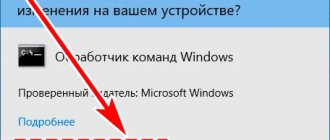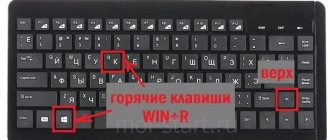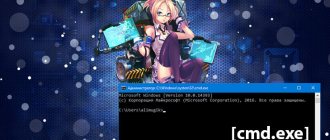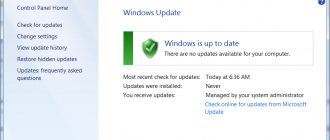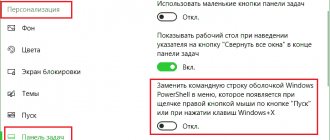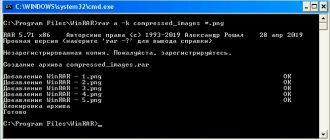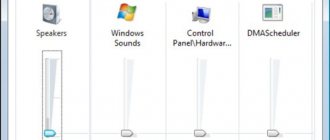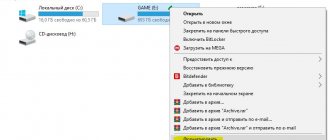There are several ways in which it is possible to open the command line in Windows 10. Thanks to the system tool, you can solve problems of varying levels and complexity by entering the necessary commands. Unlike previous versions of the OS, many important tools are difficult to find, so in the “System Administrator's Blog” we will analyze in detail all the methods for opening the command line.
Why are there so many options for opening the utility? The fact is that different tasks need to be performed, so there are different methods. It should be noted right away that the equivalent of the command line in the tenth version of Windows OS is the PowerShell utility. It has the same features, but has a more flexible and visually pleasing graphical interface and advanced features.
Key combination
the command line is the combination Win + X. In the menu that appears next, you can select one of the options:
- with limited rights;
- launch the utility with extended rights.
Both options are present in the menu that appears after pressing the key combination. It is also possible to use both methods of opening the command line at once. In addition, this menu has convenient tools that you should familiarize yourself with. Win + R allows you to quickly jump to important operating system tools.
If a PowerShell tool is displayed instead of a line in the menu list, you can return the original option according to the instructions:
1. Click on the “Start” icon and go to system settings by clicking on the gear icon.
2. In the window that appears, select the “Personalization” section.
3. Click on "Taskbar" in the left panel.
4. Turn the switch to the inactive state opposite the item to replace the command line with PowerShell.
It is worth noting that you can go to this menu if you click on the “Start” button with the right mouse button.
Starting the console when booting from removable media
To launch the command line, Windows hotkeys when starting from removable media, for example, from any boot, installation or recovery disk, are used in a single combination - Shift + F10 (and for all versions of the system, and for all types of software present on the disks) .
Note: to exit the console when you are finished working with it, it is best to use the exit command, after which you can move on to other menu items by navigating through them using additional keys, as described in the examples above.
System search
Another way to launch a command line is to search for the utility through the Windows search bar. To call it, you can use the Win + S or click on the magnifying glass icon in the lower taskbar on the left.
Once the search bar is open, proceed as follows:
1. Enter the CMD .
2. The best match for the request - Command Line - will be displayed at the top.
3. Right-click on the tool and select the Run as administrator option.
Also, the launch method will appear in the right panel if the corresponding interface is activated in the personalization of the Start menu.
Another option for launching a line with extended rights does not require the use of a mouse. To do this, select the utility in the search results using the arrows, then simultaneously hold down Ctrl + Shift + Enter .
Virtual desktops
When Windows OS users work with virtual desktops created, the corresponding key combinations on their computer keyboard are used.
There are literally several of them, but it won’t hurt to remember the combinations.
- Win and Tab. Opens task views;
- Win, Ctrl and D. This should be pressed to add another required virtual desktop;
- Win, Ctrl and left arrow. Switches directly between virtual desktop screens to the right side (left to right) on Windows 10;
- Win, Ctrl and left arrow. The same thing, only from right to left;
- Win, Ctrl and F4. Closes the desktop virtual desktop in use.
That's it, these are all the combinations available in this section.
Task Manager
You can call the command line through the system utility Task Manager. This method is suitable if the operating system is frozen and does not respond to calling the Start menu or other user actions.
To call the utility, proceed as follows:
1. Simultaneously hold down the Ctrl + Alt + Delete on your keyboard.
2. In the window that opens, select “Task Manager”.
3. A new window will open where you need to click on the “File” tab.
4. Select the “Run new task” option.
5. In the dialog box, write cmd.exe or CMD.
6. Click on the Enter key or click on “OK”.
Below the line, you can check the option to open the tool in advanced administrator mode.
It is also possible to open the Command Prompt without entering commands through the Task Manager. To do this, hold down the Ctrl and, without releasing it, click on “File”, then click on the function to create a new task. After this, the utility is in administrator mode.
Options
There are also combinations for the “Options” window.
There are literally 3 of them. They look like this:
- Win and I. Opens options;
- BackSpace. Returns to the main (home) settings page;
- When you enter a symbol on any page where there is a search field, the search for parameters is activated.
That's all. Just a few combinations, which are extremely easy to remember.
There is no need to sit and memorize all the combinations. Moreover, it is not at all necessary to use them.
But in many situations, it is much easier to press a couple of buttons to copy and paste the same text than to carry out several lengthy mouse manipulations.
Here, each user decides for himself what and how it is more convenient for him to do. But combinations exist for a reason. They are convenient, useful, and in most cases easy to remember.
What combinations do you use? Do you consider these useful features of operating systems or would it be no worse without them?
Share your opinion on this matter, leave comments, ask your own questions on the topic!
Run Dialog Box
The Run dialog box is one of the most common ways to launch various system tools and installed applications. But to run the tools you need to know the queries. In the case of a string, the command is the same as the name of the executable file - CMD.
To run a line through the Run window, proceed as follows:
- Simultaneously hold down the Win + R .
- In the window that opens there is a line for requests. Enter the CMD command.
- Click on the “OK” button or the Enter key to open the utility.
The disadvantage of this method is that the application automatically starts in limited account mode.
Multimedia features
- Win + Print Screen - take a screenshot (screenshot), the screenshot will be saved in a specially created “Screenshots” folder, which is located in the “Pictures” folder.
- Win + G - opens the Game DVR panel for recording video in games (set up on Xbox).
- Win + Alt + Print Screen - take a screenshot of the game.
- Win + Alt + R - start recording, when pressed again - stop recording.
- Win + Alt + G - Record the last 30 seconds in the active window.
- Win + P - switch between displays, if there is a second display.
- Win + “plus” - increase using the Magnifier application.
- Win + “minus” - reduce using the Magnifier application.
Start Menu Apps
The Start menu in the Microsoft operating system contains almost all installed and system utilities and programs. To search for a command line, use this method:
- Click on the Windows icon located in the lower taskbar on the left.
- All software is sorted in alphabetical order. Find the "Service" section and expand it.
- In the list that appears, by default, there is the “Command Line” utility.
When you simply open the program with one click of the left mouse button, it will start in limited account mode. To use it with administrator rights, right-click on the name, then hover over the “Advanced” item. In the list that opens, select the appropriate option.
Command line
- Ctrl + C or Ctrl + Insert - copy the selected test.
- Ctrl + V or Shift + Insert - inserts text at the cursor position.
- Ctrl + M - select on the command line.
- Ctrl + A - selects all text in the current line; if there is no text in this line, then all text in the command line will be selected.
- Shift + ← (left arrow) - selects one character located to the left of the cursor.
- Shift + → (right arrow) - selects one character located to the right of the cursor.
- Shift + ↑ (up arrow) - select a character, and then the entire line up.
- Shift + ↓ (down arrow) - select a character, and then the entire line down.
- Ctrl + Shift + ← (left arrow) - select one word that is located to the left of the cursor.
- Ctrl + Shift + → (right arrow) - select one word that is located to the right of the cursor.
- Shift + Home - moves the cursor to the beginning of the current line.
- Shift + End - moves the cursor to the end of the current line.
- Ctrl + ↑ (up arrow) - move one line higher.
- Ctrl + ↓ (down arrow) - move one line lower.
- Ctrl + Page Up - move one page up in the command line.
- Ctrl + Page Down - move one page down in the command line.
- Ctrl + F - opens a search window in the command line.
- Alt + F4 - close the command line.
Windows Explorer
There are several ways to open the tool through OS Explorer. Let's look at each of them in more detail.
Method 1: Find the executable file
The file that launches the line is located on the local drive C. You can find the directory through the system Explorer. To get started, open the built-in file manager using one of the following methods:
- Click on the Explorer icon in the lower taskbar. It is located on the left, next to the Start menu.
- Use the hotkey combination Win + E.
- Use Windows system search.
- Find the application in the Start menu under System Tools.
After opening File Explorer, go to your local drive C if it is the system drive. Then find the Windows folder, and in it open the System32 directory. It contains the cmd file. The terminal can be launched with administrator rights by calling up the context menu with the right mouse button and selecting the appropriate item.
Also, after double-clicking the left mouse button on the application icon, Command Prompt will open with limited capabilities.
Method 2: Explorer address bar
You can open the tool using Explorer through its address bar. To do this, launch the system utility using one of the methods described above, then do the following:
- Place your cursor on the top address bar.
- Type CMD.
- Press the Enter key on your keyboard.
After this, the utility will start, but without administrator rights. This is one of the most convenient and quick methods that can be useful to solve simple problems.
Method 3: File Explorer menu
The following method of calling the command line from Explorer allows you to select the utility mode. First, go to the directory that will be the starting directory for the application. Then follow the instructions:
- Hold down the Shift key on your keyboard.
- Left-click on the top “File” menu.
- Hover over "Run Windows PowerShell." In some versions of the OS, the item will be called the command line.
- In the additional list, select the launch mode, including with extended rights.
The method is also one of the fastest. The main thing is not to forget to hold down Shift, otherwise the menu item will be highlighted in gray - this means that it is not active.
It should be noted that while holding down the Shift key, you can click on a free area of Explorer or on a folder. In this case, a new option will appear in the additional menu - “Open a PowerShell window here.” But the tool will not have expanded access.
Examples of using
Using the command line, you can solve many different tasks - from managing the server to searching for files. But all the power manifests itself in cases when we need to do many of the same type of operations.
Let's imagine this situation: we downloaded 30 podcasts that we want to listen to on the road. But after downloading, it turned out that the volume of all recordings is very quiet, and even if you turn everything up to maximum, it is still not enough. To listen to podcasts, we will have to:
- launch audio editor,
- open each file in it in turn,
- manually set the desired volume level,
- save file,
- open the next one and repeat the same thing,
- repeat 28 more times
Obviously, this will take a lot of time, and it is easier to download other podcasts than to spend so much effort on these ones. But, for example, in MacOS we can open a terminal and write two commands there:
cd podcasts for file in *; do wc -l $file; lame --scale 8 $file; done
The first command goes to the directory with podcasts, and the second:
- takes all files in this folder;
- receives their number and name;
- launches the lame program in a loop and specifies parameters for it - increase the volume of this file by 8 times;
- repeats the loop until all files have been processed.
As a result, we will receive the same files in the same folder, but with increased volume. It will be much faster in terms of time than doing everything manually. But for this you need to know the capabilities of the command line, be able to work with it, know the commands and their parameters.
Here's what else you can do via the command line:
- monitor the load on the processor;
- configure automatic program updates;
- make scheduled backups;
- generate texts using neuron and immediately publish the result in the Telegram channel;
- collect mail from all mailboxes, filter only important letters, collect them into one, design it beautifully and print it out;
- and anything else, if there is a command or call parameter for this.
